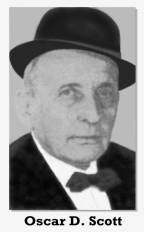
(EDITOR’S
NOTE: Oscar D. Scott, a long time resident of
this area, has written the following historical
piece about the coast. It
was submitted as a letter to the editor.)
About the beginning of this century,
Charles Lawrence Dyer wrote a book on his sojourn
along the Mississippi Coast.
He also put out a pictorial review
of the resorts, businesses and towns along the way.
He started the trip at New Orleans,
La., and stopped at Mobile, Ala.
He reported Scranton (which is now Pascagoula)
with a population of 3,000 and Moss Point, 4,500. So at that time Moss Point was far larger than Scranton
(Pascagoula.)
In reporting Moss Point’s industry, Dyer
wrote, “One of the largest lumber and sawmill plants in the South, in
fact in the U.S., is located here.
It has a capacity of 175,000 board feet per day
and a planer mill with a daily capacity of 40,000 feet.
I am referring to the L. N. Dantzler Lumber Co.
which exports lumber to Mexico, Central and
South America and the West Indies.
L. N. Dantzler Sr., president and treasurer of the company, was
with the W. Griffin Co. in 1875 when he bought Griffin out
and went into business for himself.
In the year 1885 he built the mills larger.
In 1888 he incorporated the business and
business and brought his sons into the
corporation with J. L. Dantzler, |
|
secretary, and L. N. Dantzler
Jr., vice president.”
So much for the Dyer Report.
THE
DANTZLER
CO.
owned a tugboat named the “Bessie Dantzler” which
was said to be the largest steam tug in the South.
The company also owned two
more very large tugs
named “The Laura” and “The
Lee Kimball.” They also
owned two small steam tugs, “The Toiler”
and “The Pic” with a fleet of lighter barges.
The W.
Denny & Co. mill was situated in
the center of Moss Point.
The mill had a capacity of
100,000 board feet per day with 20,000 feet for the planer mill.
In 1902 the
company decided to expand.
It built a railroad
from Moss Point to Evanston near Lucedale.
They
also purchased thousands of acres
of virgin pine timber adjacent to the right-of-way of
the road. In 1906 after the
completion of this railroad, they examined
their books and reported
to their stockholders that they would make $1 million
in 1907. Along came the September 1906
hurricane and blew their timber flat on the ground
where it spoiled before it could be harvested, and W.
Denny & Co. bankrupted.
I take off my hat
to the engineers and surveyors who selected the route of this
railroad, although they had not the modern
equipment such as airplanes and
helicopters that are used today.
No one can improve on the route
they chose. Only
two bridges had to be constructed on the
whole route, one at Ford across Dog River,
another over Black Creek at Helena.
There were two stations on
this railroad that were
established originally that are not in use
today. One is “Nutbank”
which was between Helena and Big Point.
The other is “Vaughn Switch”
between Agricola and Evanston. The person or persons who named the station
at Agricola must have been well Agricola
must have been well schooled in medieval history.
Julious Gnaves Agricola was a Roman
general who ruled Britain |
|
from 37 to
93 A .D.
The
word “agriculture” is derived from his name.
THE
DENNY
ROAD,
now
named the Mississippi Export, follows
the dividing line of the watershed between the Pascagoula and
Dog Rivers. The water that
falls west of the road finds its way to the
Pascagoula River. That which
falls east goes to the Dog River.
The town of
Moss Point has in the past been home to some
interesting and lovable characters.
I will name one out of many.
He is the Hon. Ruff Borden, at times mayor
and Justice of the Peace of Moss
Point. He was large of
stature in numerous ways. Only
one flaw he possessed – he was a
drinking man. He
liked whisky. When he drank, it never seemed
to influence him except to make his complexion
more ruddy. During
the noble experiment called national
prohibition, Mayor Borden was hard-put
to obtain his favorite beverage.
While Mayor at one stage someone found a
boxcar on a siding in town loaded
with lumber and bottles of Bond whisky.
Mayor Borden started carting the booze
off to his house.
Soon others followed.
There was a hot time in the old town that night.
Another time during his tenure
in office, a law officer arrested a man for selling whiskey.
He deposited a quart bottle with His Honor
to be used as evidence in the upcoming trial.
When the case came up for trial the
police were really flabbergasted on learning the mayor, who
was also the presiding judge, has drunk the evidence.
Oscar
D. Scott
Escatawpa, Miss. |
